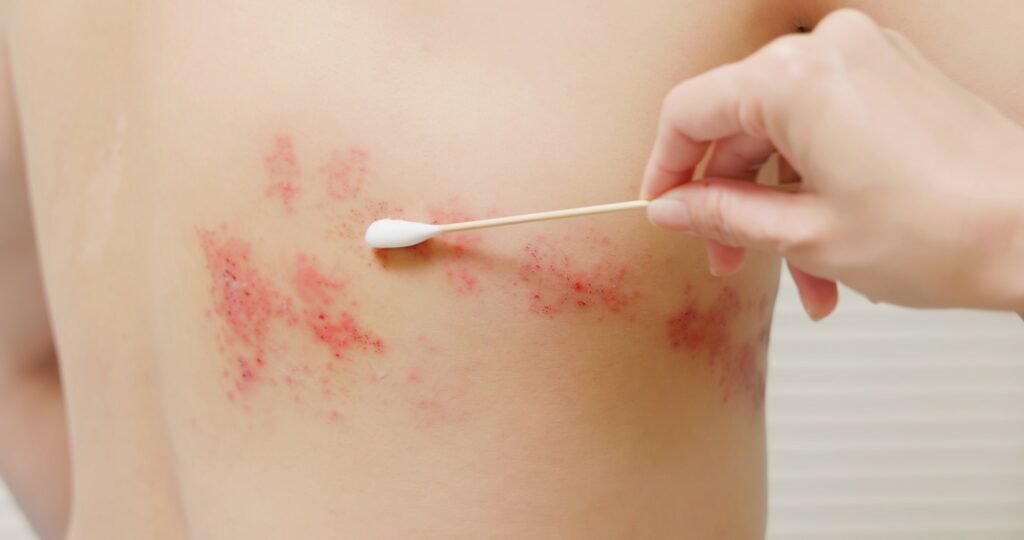Shingles, Hives, and Other Adult Skin Conditions

Shingles and hives, along with a few other skin conditions, are things many adults deal with. Stress is one of the most significant contributors to breakouts of most of these skin conditions. If it doesn’t cause the breakout, stress can exacerbate it. Adults covered in a rash or spots experience itchiness caused by breakouts or flare-ups. When skin is inflamed, it can change color and texture. Spots and rashes can occur because of an infection, contact with an irritant or a chronic skin condition. Shingles and hives are two common skin conditions that a professional dermatologist should evaluate. Although most symptoms are minor and easily treatable, more serious conditions and chronic issues, do require closer examination and may necessitate lifelong treatment.
Shingles
Shingles’ medical term is Herpes Zoster. This condition is characterized by a rash in clusters of raised dots that develop into blisters. Shingles can be incredibly painful and may include symptoms such as burning, tingling, and itching. Shingles are easily irritated by clothing, and the area can become incredibly sensitive. Although shingles often appear on the torso or lower half of the body, they can occur anywhere. Shingles lasts about two weeks, but the pain and itching can persist for months or years, and some individuals experience it for the rest of their lives. Shingles are also contagious. When it is in blister form, there should be no skin-to-skin contact or shared materials that may be infected.
Shingles Treatment Isn’t for the Roof
Shingles is a type of herpes, so treatments will include a cream for the skin, steroids, and antiviral drugs. In some cases, the condition of shingles in severe form can cause depression and isolation, so a medical professional may also prescribe antidepressants. Shingles are not something to ignore. They should be treated early to avoid complications.
Hives can Hurt
Urticaria, or hives, are more like welts. But they also sting, burn, and itch. Hives differ in that they vary in size and can sometimes merge together. Hives appear anywhere on the body and can be temporary or last for several days. Some of the. The most common causes of hives in adults are extreme temperatures, infections, medication and food allergies, and extreme heat and sweating. Creams are often prescribed, as well as antihistamines, which can treat most hive cases.
Sorry About Psoriasis
Psoriasis will appear on the skin as areas of red patches on the skin that appear to be covered in scales of white or silver. Psoriasis is the result of new skin cells building up and growing too quickly. A weakened immune system can cause psoriasis breakouts. Although the cause is unknown, the patches are typically seen on the elbows, knees, scalp, and lower back. Psoriasis can come and go throughout a person’s life, so finding an affordable treatment is important. Is essential. Moving forward. In addition to topical creams, ointments., and medications, light therapy and injections can also help the condition.
Eczema is More Than Dry Skin
Eczema is a broad term used for noncontagious skin conditions that cause the skin to become red, dry, and inflamed. One of the symptoms is itchiness. Although doctors aren’t sure what triggers eczema, they know that stress, soaps, allergens, and temperatures can cause flare-ups that most often appear in the folds of the skin. Eczema can spread on the body, but it is not contagious to others. Those seeking relief can consult a licensed dermatologist specializing in eczema treatments.
Rosacea’s Rosy Cheeks
Although some people find rosy cheeks cute, those who suffer from rosacea often experience frequent flushing, which certain foods, extreme temperature changes, stress, and other environmental factors can trigger. The rosiness shows up on the cheeks, the nose, the chin, and sometimes the forehead. Extreme cases of rosacea can develop into bumps and pimples, and when it affects the eyes. It can be dangerous, so it’s best to have a licensed dermatologist evaluate it.
Cold Sores Are Contagious
Cold sores, also known as fever blisters, are embarrassing and contagious. Herpes simplex is the cold-sore virus that causes cold sores, characterized by painful, fluid-filled blisters on the mouth and nose, which are highly infectious. Cold sores typically last 10 days but are easily spread. When a breakout occurs, it is best to avoid skin-to-skin contact in the area of the blisters. Lip products, toothbrushes, cups, utensils, or anything that might touch the blisters should not be shared. Too much sun can cause a cold sore, as well as hormonal changes and fever. Those who regularly suffer from cold sores may want to consider getting a prescription for antiviral pills to take at the onset to minimize the breakout. If a cold sore is spreading or irritating the eyes, medical professionals should be sought out immediately.
If you are suffering from shingles, hives, cold sores, psoriasis, eczema, or rosacea, you don’t have to stay isolated and be out of commission. All these conditions are treatable, and severe cases should be treated by a professionally trained dermatologist or medical professional. If you have concerns about your skin, contact Buckhead Dermatology today for an appointment. Dr. Sherrie Straughn welcomes new clients and would be happy to help find an affordable solution for your skincare concerns.
